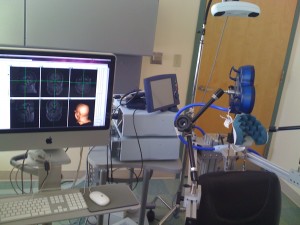 Transcranial Magnetic Stimulation (TMS) provides and effective non-invasive tool for stimulation of axonal pathways in the brain. The effect of TMS is limited to the superficial layers of the brain, such as the neocortex and the cerebellum. However, because the stimulation acts on axons as well as on cell bodies, it may also effect neuronal targets of the stimulated area. Because the current we induce with TMS is weak to be safe, our goal is rather to perturb the ongoing neuronal activity than evoking it. We use an image guided TMS system (Brainsight) that allows us to navigate relative to volumetric MRI/fMRI data taken from our subjects and achieve a higher precision targeting. We plane two experiments:
Transcranial Magnetic Stimulation (TMS) provides and effective non-invasive tool for stimulation of axonal pathways in the brain. The effect of TMS is limited to the superficial layers of the brain, such as the neocortex and the cerebellum. However, because the stimulation acts on axons as well as on cell bodies, it may also effect neuronal targets of the stimulated area. Because the current we induce with TMS is weak to be safe, our goal is rather to perturb the ongoing neuronal activity than evoking it. We use an image guided TMS system (Brainsight) that allows us to navigate relative to volumetric MRI/fMRI data taken from our subjects and achieve a higher precision targeting. We plane two experiments:
- Treating Generalized Tonic-Clonic Epilepsy by Inhibiting bilateral Thalamic nuclei with Low Frequency rTMS applied to bilateral Lateral Cerebellum and the Medial Cerebellum
- Investigation of Visual Motion Integration by using Transcranial Magnetic Stimulation
- The effect of interocular delays on the perception of 3D movies (POSTER)
